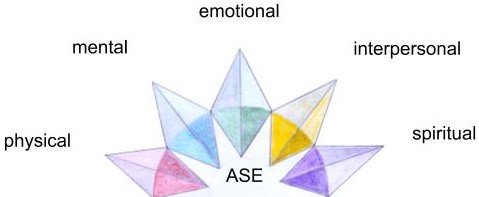This website uses cookies so that we can provide you with the best user experience possible. Cookie information is stored in your browser and performs functions such as recognising you when you return to our website and helping our team to understand which sections of the website you find most interesting and useful.
- The Authentic Self Empowerment (ASE) Practice -
The ASE Practice is about empowering yourself on all levels – physical, mental, emotional, interpersonal and spiritual – cultivating your potential on each level and bringing more of you to life.
.

.
.
The ASE Practice is inspired by three main concepts
- The Integral Transformative Practice – which is an approach to personal growth and transformation developed by George Leonard, Michael Murphy and Ken Wilber.
. - The Participatory Perspective – as exemplified by the work of Jorge N. Ferrer.
. - The fundamental ASE approach known as Open Awareness – which involves a diverse variety of mindfulness based skills and exercises to expand awareness, including the Jumi (judo-mind) practice – developed by Jevon Dangeli
.
.
 The essential idea of Integral Transformative Practice (ITP) is that the more human capacities one exercises simultaneously, the more one is able to access their full potential for growth and transformation. Think of it as spiritual cross-training: the exercise of body, mind, soul, and spirit in self, culture, and nature [1].
The essential idea of Integral Transformative Practice (ITP) is that the more human capacities one exercises simultaneously, the more one is able to access their full potential for growth and transformation. Think of it as spiritual cross-training: the exercise of body, mind, soul, and spirit in self, culture, and nature [1].
Leonard and Murphy describe ITP as a long term program for realizing the potential of body, mind, heart, and soul [2]. They also refer to ITP as a comprehensive, systematic, holistic approach to personal transformation. Ferrer believes that ITPs should foster the creative transformation of the embodied person and the world, the spiritualization of matter and the sensuous grounding of spirit [3]. According to Ferrer, practices that promote a participatory perspective may gradually enable practitioners to embody both transcendent and immanent spiritual energies – a twofold incarnation, so to speak – promoting the realization that it is here, in this plane of physical reality, that the cutting edge of spiritual transformation and evolution can take place [3].
 The idea is to engage in a practice that involves the five general domains of life (physical, mental, emotional, interpersonal and spiritual) simultaneously, so that you can create the synergistic energy to propel your life forward. Real transformation isn’t easy, however, it is made possible and meaningful when you choose to be in the world authentically. Like other ITPs, the ASE Practice joins body, mind, heart, and soul in an evolutionary adventure that can have profound personal and social implications. This integrative practice incorporates five domains to co-creatively participate in the process of integral growth.
The idea is to engage in a practice that involves the five general domains of life (physical, mental, emotional, interpersonal and spiritual) simultaneously, so that you can create the synergistic energy to propel your life forward. Real transformation isn’t easy, however, it is made possible and meaningful when you choose to be in the world authentically. Like other ITPs, the ASE Practice joins body, mind, heart, and soul in an evolutionary adventure that can have profound personal and social implications. This integrative practice incorporates five domains to co-creatively participate in the process of integral growth.
What makes the ASE Practice unique is its basis on the fundamental ASE approach of Open Awareness (OA)[4], which involves a diverse variety of mindfulness based skills and related exercises, including the Jumi (judo-mind)[5] approach, with specific applications in each of the five domains – physical, mental, emotional, interpersonal and spiritual.
 While anyone is welcome to make use of the free ASE Practice guidelines and OA resources provided below, those who want customised guidelines and the full range of resources may want to consider learning OA more comprehensively through online training in OA.
While anyone is welcome to make use of the free ASE Practice guidelines and OA resources provided below, those who want customised guidelines and the full range of resources may want to consider learning OA more comprehensively through online training in OA.
To have a personalised ASE Practice developed for you based on your dominant needs, values and goals in all five domains, the ASE Integrative Coaching Program is recommended.
The success and sustainability of the ASE Practice pivots on the fulfilment of your dominant needs, values and goals in each of the five domains. Simply put, you can set yourself up for success in the long term by ensuring that everything is in place for you to be motivated to engage in your practice on a daily basis, without hindrance. For this purpose, the professional guidance and support of a Licensed ASE Facilitator or Transpersonal Coach can be of tremendous value.
.
ASE Practice Guidelines and Resources
.
Below are general ASE Practice guidelines and free resources. These can be adapted according to your particular needs and goals. Select any one or more of the suggested practices in each domain, while bearing in mind that the quality and regularity of your practice is more important than a high quantity of practices done irregularly. The points and links seen in each domain include both resources and suggested practices. The resources serve as learning tools. The suggested practices are examples of how to apply those resources in your practice. It should be noted that there are other suitable practices for each domain. The resources below are specific to the ASE Practice, however, any of them could be replaced by other practices that you are familiar with.
.
Physical Domain
The core objective of jumi is to develop open awareness (embodied mindfulness) and the ability to maintain it in all contexts. In order to be successful in any pursuit, one must be adaptable to change. Practising jumi develops mindful adaptability, which in turn leads to openness, flexibility and efficiency:
– open to all aspects of your present reality, cultivating
– flexible states and perspectives for
– efficient actions leading to successful outcomes.
.
- Visit the jumi training videos site and select a jumi sequence or “awarenessing” exersize to suit your current physiological state. In terms of physical fitness, the full jumi sequence is great for building core-strength and improving flexibility, while mild for cardiovascular conditioning.
.

Open Soma Awareness
While the open soma awareness practice does not include much physical output, it helps to cultivate the awareness of what your body’s current needs are in terms of water, food, movement, rest, healing, etc.
.
- Listen to the open soma awareness guided meditation as often as necessary – until you are able to do the practice yourself without listening to the recording.
.
.
Mental Domain
.
 Stimulate your mind. The mind is stimulated by experience, which involves having new experiences as well as repeated experiences. New experiences grow new neural networks in the brain. These may include developing new skills, experimenting – trying out new things, looking at situations from different perspectives, and simply breaking your own moulds through taking steps beyond your comfort zone. Repeated experiences include all thinking processes and activities that involve repetition. Repetition strengthens existing neural networks and develops unconscious competency and habits, so choose wisely what you do repetitively.
Stimulate your mind. The mind is stimulated by experience, which involves having new experiences as well as repeated experiences. New experiences grow new neural networks in the brain. These may include developing new skills, experimenting – trying out new things, looking at situations from different perspectives, and simply breaking your own moulds through taking steps beyond your comfort zone. Repeated experiences include all thinking processes and activities that involve repetition. Repetition strengthens existing neural networks and develops unconscious competency and habits, so choose wisely what you do repetitively.
Activate your whole brain. Include activities each day that activate both the left and right parts of the brain. The ‘left brain’ is activated through linear processing (e.g. logical thinking and objectivity) and the ‘right brain’ is activated through non-linear processing (e.g. creativity and meditative exercises).
Use psychological skills to improve mental performance. Authentic Self Empowerment (ASE), Neuro-Linguistic Programming (NLP) and Humanistic Neuro-Linguistic Psychology (HNLP) all include effective psychological skills to help you understand why you do what you do and how to upgrade what you do when you’d like to do better – better performance – better sleep – better access to your full potential.
Develop mental hygiene. Regularly reflect on your thought patterns and personal ethics – the ideas and mental processes behind your decisions and actions. For example, look back upon some recent situations that you were involved in with the aim to identify if your thinking was driven more by attempts to satisfy the ego, or more to fulfil higher (broadly beneficial) values? Being in open awareness helps you to dissociate from your regular thought streams, which in turn makes it easier to identify your thinking process and reflect on your personal ethics.
 Keep learning and seeking inspiration. Take time each day to do what inspires you. Some examples: Engage in discussions with people who have knowledge and interest in the subjects that fascinate you. Read content that stretches your mind and evokes reflection. Listen to uplifting programs, watch stimulating documentaries, and make use of the free ASE training videos.
Keep learning and seeking inspiration. Take time each day to do what inspires you. Some examples: Engage in discussions with people who have knowledge and interest in the subjects that fascinate you. Read content that stretches your mind and evokes reflection. Listen to uplifting programs, watch stimulating documentaries, and make use of the free ASE training videos.
Expand your horizons. Visit places and do things that are unfamiliar to you. Learn about other cultures and traditions. Stay plugged into what’s new in the world – in all your areas of interest and beyond. Regularly remind yourself that you are more than you think you are, then contemplate the significance of that.
- Free ASE, NLP & HNLP training videos
. - Mind expanding ASE guided process – free mp3
. - Keep a personal journal (e.g. Spacebook) – as a means to reflect on your thought patterns and personal ethics
.
.
Emotional Domain
.
 Be in touch with your feelings and learn to identify all their characteristics. Welcome your emotions. The more you allow emotional feelings to arise and unfold, without trying to suppress or control them, the more you will discover about yourself. Meet your emotions with open awareness – watching them, feeling how they feel and noticing the thoughts that they result in. Open awareness enables you to be the experiencer of your emotions without becoming their victim. This quality of observing your emotions with self-compassion enables you to dissociate from their mental aspects that cause suffering, which in turn makes distressing phases more manageable. In this way you equip yourself to learn and grow from your emotions, and respond to them with equanimity.
Be in touch with your feelings and learn to identify all their characteristics. Welcome your emotions. The more you allow emotional feelings to arise and unfold, without trying to suppress or control them, the more you will discover about yourself. Meet your emotions with open awareness – watching them, feeling how they feel and noticing the thoughts that they result in. Open awareness enables you to be the experiencer of your emotions without becoming their victim. This quality of observing your emotions with self-compassion enables you to dissociate from their mental aspects that cause suffering, which in turn makes distressing phases more manageable. In this way you equip yourself to learn and grow from your emotions, and respond to them with equanimity.
Resistance is persistence! Trying to block or suppress emotions is what intensifies them. Having the attitude that it is okay to feel what you are feeling and inviting the feeling to be there, not only helps you to cope with difficult emotions, it enables you to trace where they come from (what triggers them), as well as how to adequately release residual emotional energy from the body.
 Some people are not in touch with their emotions and are not easily able to identify their feelings. The result is frequently that such individuals ‘live life in their heads’ and are often unable to respond to challenges with much emotional intelligence or empathy toward others. They generally take a disassociated view on situations, which might be useful in certain instances, but it makes being empathetic and compassionate difficult. This is often to do with emotional trauma in their past. In addition to seeking professional help, such individuals should be encouraged to regularly engage in soma centred practices such as jumi awarenessing and open awareness meditations.
Some people are not in touch with their emotions and are not easily able to identify their feelings. The result is frequently that such individuals ‘live life in their heads’ and are often unable to respond to challenges with much emotional intelligence or empathy toward others. They generally take a disassociated view on situations, which might be useful in certain instances, but it makes being empathetic and compassionate difficult. This is often to do with emotional trauma in their past. In addition to seeking professional help, such individuals should be encouraged to regularly engage in soma centred practices such as jumi awarenessing and open awareness meditations.
- Keep a personal journal (e.g. Spacebook) – as a means to reflect on your feelings and their meaning or message(s)
- Cultivate self-compassion – allowing feelings and emotions to be present with care
- Take a daily dose of laughter 😉
.
.
Interpersonal Domain
 Relationship Resourcing
Relationship Resourcing
Nobody shows up in your life by accident. Those who have the greatest impact on you (whether positive or negative) are the valuable people in your life – cherish those relationships, even if you choose to walk away from any of them. We can learn a great deal about ourselves from the feedback (verbal and non-verbal) that we get from others.
The ASE Relationship Resourcing skills can help to resolve relationship issues, as they enable you to experience interpersonal dynamics from four different perceptual positions, including the OMNI (Open Mind New Ideas) perspective, which in turn helps you to have a balanced and empathic perception, as well as compassionate responses.
- Watch a Relationship Healing training video in which a method to establish the different perceptual positions is taught.
- Listen to a recording of an ASE Relationship Resourcing process to promote OMNI perspective (open awareness in the context of relationships).
- Aim to maintain open awareness in the presence of others – by focussing on the space in-between you and them.
.
 Shadow Work
Shadow Work
“Shadows” (in psychology) are those parts of ourselves that we deny or hide. They are the unconscious aspects of our personality that we project onto others. We can recognise our shadows by identifying situations where we have judged others, without seeing the quality being judged in ourselves. In this way our shadows can be brought into the light of your conscious awareness, which supports integration and growth.
The best a person can be in your company is equal to your internal representation of them. This means that the way we experience others is based on our perception of them, furthermore our perception of them is entangled with our perception of ourselves. In other words, our experience of others is a reflection of an aspect of ourselves.
It’s important (although not easy) to realise that those behaviours in others that we dislike most point to our own shadows. In fact, one of the most simple ways to become aware of our own shadows is to look at what we are most triggered by in others, then take back our projection through gently integrating our shadow.
- ASE Shadow Integration Process (free training video)
- Observe your opinionated thoughts about others while being curious about where those opinions stem from
- Embrace all parts of you – the good, bad, beautiful and ugly – in loving kindness
.
 Participatory Perspective
Participatory Perspective
Nobody is an island unto themselves. We are all interconnected at the most fundamental level – the vast web of life. Realising this can transform your sense of self, expand your map of reality, and change the way in which you relate to others. The participatory perspective emerges from a deep realisation of your connection with everyone and everything. This view reveals the co-creative quality of all events – from material to abstract and from personal to transpersonal [3]. Imagine how you would treat others – in your family, social circles, at work, and in all areas of life – if you had an embodied understanding of the multi-dimensional and intersubjective interplay of phenomena that influence every moment of all your relationships? From this point of view all interactions with all others can be seen as meaningful and valuable. This cultivates mutual respect and compassion for ourselves and others, which can be utilized to establish balanced cooperation and enhanced co-creative potential.
- Watch an open awareness training video – promoting the participatory perspective
. - Between ‘you’ and ‘me’ is ‘WE’ (Whole Experience). Explore the space of ‘WE’ when interacting with others
.
.
Spiritual Domain

In the context of ASE, the word “spiritual” is nonsectarian and can be used interchangeably with the word “transpersonal”. The Authentic Self can be described as the Spiritual Self or Transpersonal Self – as these each encompass all the levels of Self – from the personal to the transcendent. On this basis, the ASE concepts and practices that have been outlined in the four domains above (physical, mental, emotional, interpersonal) also include spiritual elements. For example, the jumi practice that features in the physical domain includes the jumi meditation. Jumi and other forms of meditation, as well as any approach that promotes mindfulness or a deeper awareness of the Authentic Self can be considered a primary spiritual practice.
Davis et all [9] describe the Authentic Self as “a deep sense of integrity and connection with one’s deepest or authentic sense of self. This source of spirituality typically does not imply that the self is an object of worship, but rather it involves seeking a sense of deep authenticity, genuineness, congruence, and acceptance of the self.”
 The most versatile and practical spiritual practice in the ASE paradigm involves applied open awareness. Jumi itself is designed as a methodology to help people embody open awareness.
The most versatile and practical spiritual practice in the ASE paradigm involves applied open awareness. Jumi itself is designed as a methodology to help people embody open awareness.
- Use the open awareness resources to cultivate effortless mindfulness and as well as to explore the most inner and outer aspects of awareness until the concepts of “inner” and “outer” become obsolete
- Practice any form of meditation that resonates with you at least once daily
- Make use of the various free ASE resources and Jumi training videos
.
.
Keep Up Your Practice
.
 The practices in each of the above domains need not all be done in separate sessions, as many of them overlap or include elements of each other. Once you have gone through all the free resources in the links above, you should be able to compile your own ASE Practice involving aspects from all five domains woven into your preferred personal approach. You can go about this by yourself, or you may want to consider the guidance of a professional ASE Facilitator or Transpersonal Coach who is trained in the ASE Integrative Coaching Program.
The practices in each of the above domains need not all be done in separate sessions, as many of them overlap or include elements of each other. Once you have gone through all the free resources in the links above, you should be able to compile your own ASE Practice involving aspects from all five domains woven into your preferred personal approach. You can go about this by yourself, or you may want to consider the guidance of a professional ASE Facilitator or Transpersonal Coach who is trained in the ASE Integrative Coaching Program.
For best results your ASE Practice should be done regularly – daily is ideal. Make it part of your routine or treat it like a ritual. Understandably, there will be days when you might be unable to do your practice. You’re human too! If you have missed a day (or more), get back to your practice routine as soon as possible. Diligence to your practice will save you from losing momentum and motivation. Keep it up!
Your ASE Practice can change over time. Indeed, as you grow and evolve, so too should your practice. The point is to keep practicing and enjoy the journey!
.
.
Disclaimer
.
ASE Practice is not intended to treat or cure any mental health or medical conditions. It is not a replacement for psychotherapy or psychological counselling.
.
.
Join us for a 6-day ASE retreat in the Italian part of Switzerland
.
.
.
References
[1] Wilber, K, Leonard, G. and Murphy, M. (2004). ITP Interview. http://nhne-pulse.org/michael-murphy-george-leonard-ken-wilber-integral-transformative-practice/
[2] Leonard, G. and Murphy, M. (n.d.) Integral Transformative Practice. https://itp-dev.encryptedcommerce.net/the_non-profit
[3] Ferrer, N. J. (2012) Embodied Spirituality, Now and Then. https://www.kosmosjournal.org/article/embodied-spirituality-now-and-then/
[4] Dangeli, J. (2017) The Open Awareness Handbook. https://jevondangeli.com/wp-content/uploads/2017/11/Open_Awareness_Handbook_Jevon_Dangeli.pdf
[5] Dangeli, J. (n.d.) Jumi (judo mind) practice. http://jumi.live/concept-practice/
[6] Dangeli, J. (2017) Transpersonal Coaching – an introduction. https://authentic-self-empowerment.com/transpersonal-coaching/
[7] Dangeli, J. (n.d.) ASE Integrative Coaching Program. https://authentic-self-empowerment.com/ase-integrative-coaching-program/
[8] Dangeli, J. (n.d.) Authentic Self Empowerment. https://authentic-self-empowerment.com/
[9] Davis, D. E., Rice, K., Hook, J. N., Van Tongeren, D. R., DeBlaere, C., Choe, E., & Worthington Jr, E. L. (2015). Development of the Sources of Spirituality Scale. Journal of counselling psychology, 62(3), 503-513.

